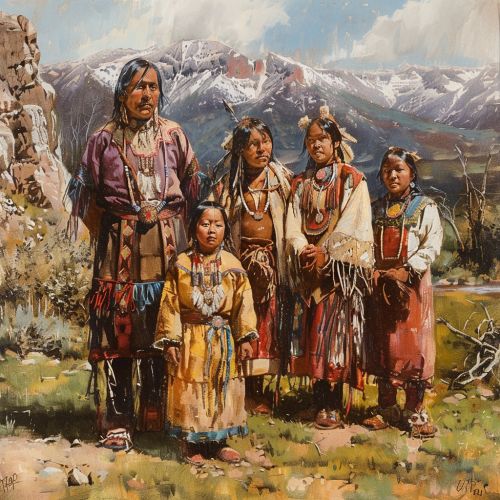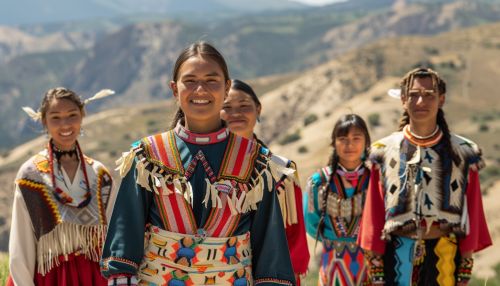Ute people
History
The Ute people are a Native American tribe indigenous to the regions that are now known as Utah, Colorado, and New Mexico. They are part of the Uto-Aztecan language family, which includes other tribes such as the Shoshone and the Paiute. The Ute people have a rich history that dates back thousands of years, with archaeological evidence suggesting their presence in the Great Basin and Colorado Plateau regions as early as 500 A.D.
Pre-Colonial Era
Before European contact, the Ute people were primarily hunter-gatherers, relying on the diverse ecosystems of the Rocky Mountains and surrounding areas. They hunted large game such as deer, elk, and bison, and gathered various plants, seeds, and nuts. The Ute were also skilled fishers, utilizing the abundant rivers and lakes in their territory.
European Contact and Colonization
The arrival of Europeans in the 16th century marked a significant turning point for the Ute people. Spanish explorers were the first Europeans to make contact with the Ute, introducing horses, which transformed Ute society. The Ute quickly became adept horsemen, which enhanced their hunting capabilities and allowed them to expand their territory.


19th Century Conflicts
The 19th century was a period of intense conflict for the Ute people. As American settlers moved westward, they encroached on Ute lands, leading to numerous skirmishes and battles. The Ute Wars, which included conflicts such as the Meeker Massacre and the Battle of Milk Creek, were significant events during this period. These conflicts ultimately resulted in the Ute being forced onto reservations, significantly reducing their traditional lands.
Modern Era
In the 20th and 21st centuries, the Ute people have worked to preserve their cultural heritage while adapting to modern society. They have established tribal governments and economic enterprises, including casinos and natural resource management. The Ute also continue to practice traditional ceremonies and maintain their language and cultural practices.
Culture
The culture of the Ute people is rich and diverse, encompassing various aspects such as language, religion, art, and social structure.
Language
The Ute language, part of the Uto-Aztecan family, is a critical component of their cultural identity. Efforts are ongoing to revitalize the language, with educational programs and resources aimed at teaching younger generations.
Religion and Spirituality
Traditional Ute religion is deeply connected to the natural world. They believe in a variety of spirits and deities associated with natural elements such as mountains, rivers, and animals. Ceremonies such as the Bear Dance and the Sun Dance are central to Ute spirituality, serving as a means of connecting with the spiritual world and maintaining social cohesion.
Art and Craftsmanship
Ute art is renowned for its intricate beadwork, basketry, and pottery. These crafts are not only artistic expressions but also serve practical purposes in daily life. Ute artists often incorporate symbols and motifs that reflect their cultural heritage and natural surroundings.
Social Structure
Traditional Ute society was organized into bands, each led by a chief. These bands were relatively autonomous but would come together for larger social and religious events. Today, the Ute tribes are organized into three federally recognized tribes: the Ute Indian Tribe of the Uintah and Ouray Reservation, the Southern Ute Indian Tribe, and the Ute Mountain Ute Tribe.
Economy
The economy of the Ute people has evolved significantly over time. Historically, they relied on hunting, gathering, and trading with neighboring tribes. The introduction of horses and European goods expanded their trade networks and economic activities.
Traditional Economy
Before European contact, the Ute economy was based on subsistence activities such as hunting, fishing, and gathering. They traded goods such as hides, meat, and crafted items with neighboring tribes and later with European settlers.
Modern Economic Activities
In the modern era, the Ute tribes have diversified their economic activities. They have established enterprises in various sectors, including gaming, tourism, and natural resource management. The Southern Ute Indian Tribe, for example, has significant investments in the energy sector, including oil and gas production.
Governance
The governance structures of the Ute tribes have evolved from traditional systems to modern tribal governments recognized by the United States federal government.
Traditional Governance
Traditionally, Ute bands were led by chiefs who were chosen based on their leadership qualities and abilities. Decision-making was often a communal process, with input from elders and other respected members of the community.
Modern Tribal Governments
Today, the Ute tribes have established formal tribal governments with constitutions and elected officials. These governments manage various aspects of tribal life, including economic development, social services, and cultural preservation. The Ute Indian Tribe of the Uintah and Ouray Reservation, for example, has a tribal council that oversees governance and decision-making.
Challenges and Future
The Ute people, like many Native American tribes, face numerous challenges in the modern world. These include issues related to health, education, and economic development.
Health and Education
Access to quality healthcare and education remains a significant challenge for the Ute people. Efforts are being made to improve these services through tribal and federal programs. Initiatives such as the Ute Indian Tribe's Health Department aim to provide comprehensive healthcare services to tribal members.
Economic Development
Economic development is a critical focus for the Ute tribes. They are working to create sustainable economic opportunities that respect their cultural heritage and natural resources. This includes investments in renewable energy, tourism, and other sectors.
Cultural Preservation
Preserving their cultural heritage is a priority for the Ute people. Efforts are being made to document and teach the Ute language, as well as to maintain traditional ceremonies and crafts. Cultural centers and museums, such as the Southern Ute Cultural Center and Museum, play a vital role in these efforts.
